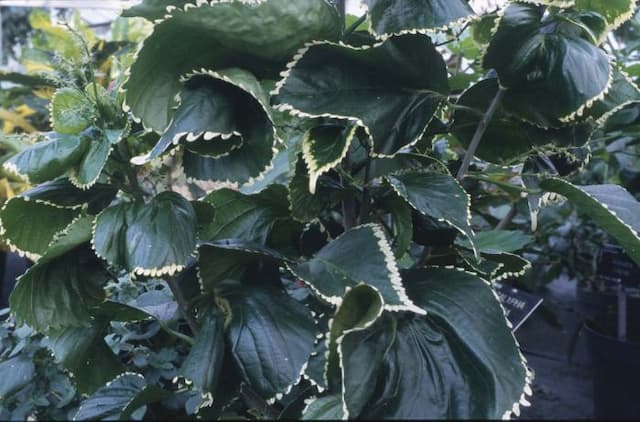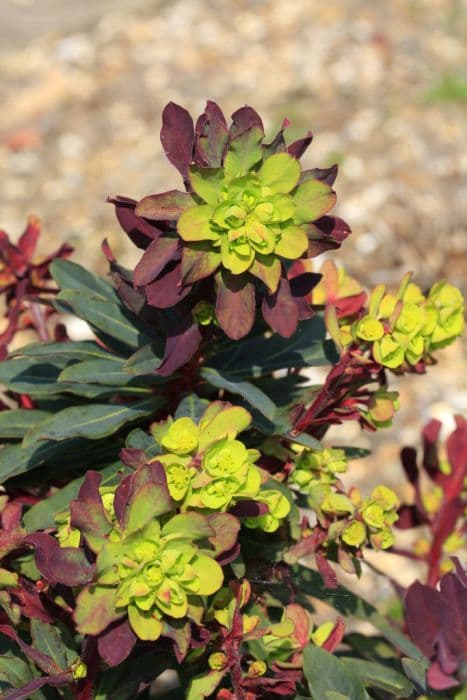Albanian Spurge Euphorbia nicaeensis subsp. glareosa

ABOUT
Euphorbia nicaeensis subsp. glareosa, commonly known as the spurge, is a hardy, perennial plant that typically grows in open, rocky environments. This species of spurge is characterized by its compact clusters of narrow, green leaves that emanate from a central point, forming a radial pattern that can resemble a spiky rosette. The leaves are fleshy, which suggests that the plant is well adapted to arid conditions, storing water to survive in its harsh native habitat. The surface of the leaves often features a waxy or slightly bluish coating, which helps to reflect sunlight and minimize water loss. During its blooming period, the spurge produces small flowers that are typically yellow and inconspicuous. These flowers are encased in specialized structures called cyathia, which are cup-like and hold the true flowers and nectar glands. The cyathia give the blossoms a distinctive look, clustered together in the center of the leafy rosette. Unlike some of its relatives in the Euphorbia genus, which can have a more branching or sprawling habit, this subspecies has a more upright and contained posture. The overall appearance of the plant is sculptural and can add an interesting texture to a rock garden or a drought-resistant landscape. It's important to handle the spurge with care, as like many members of the Euphorbia family, it contains a milky sap that can be irritating to skin and eyes.
About this plant
 Names
NamesFamily
Euphorbiaceae
Synonyms
Albanian Spurge
Common names
Tithymalus nicaeensis, Euphorbia nicaeensis, Euphorbia nicaeensis var. glareosa, Galarhoeus nicaeensis.
 Toxicity
ToxicityTo humans
Euphorbia nicaeensis subsp. glareosa is commonly known as spurge. Spurges are known for their toxicity to humans due to the presence of a milky sap called latex, which contains irritant chemicals such as diterpene esters. If any part of the plant is ingested, the latex can cause symptoms such as burning pain in the mouth and throat, nausea, vomiting, and diarrhea. It can be particularly dangerous for the eyes and skin, leading to severe irritation, redness, and swelling. In some cases, contact with the sap can result in systemic reactions, which might be severe and require medical attention.
To pets
Spurge is toxic to pets as well. The plant contains a latex sap that can lead to a variety of symptoms if ingested or if it comes into contact with the pet's skin or eyes. Symptoms of poisoning in pets include drooling, vomiting, diarrhea, and potentially intense irritation or burning sensation at the point of contact. In severe cases, if the sap enters the pet's eyes, it may cause temporary or permanent blindness. Pet owners should exercise caution and prevent pets from coming into contact with spurge due to its toxic nature. If a pet is suspected of ingesting parts of the plant or having significant contact with the sap, prompt veterinary attention is advisable.
 Characteristics
CharacteristicsLife cycle
Perennials
Foliage type
Evergreen
Color of leaves
Green
Flower color
Yellow
Height
2 feet [0.61 meters]
Spread
2 feet [0.61 meters]
Plant type
Herb
Hardiness zones
8
Native area
Mediterranean
Benefits
 General Benefits
General Benefits- Landscape enhancement - Euphorbia nicaeensis subsp. glareosa can be used to add aesthetic appeal to gardens with its unique form and foliage.
- Drought tolerance - Adapted to dry conditions, it requires minimal watering once established, making it ideal for xeriscaping and low-maintenance landscapes.
- Soil stability - Its root system helps in preventing soil erosion, particularly in rocky or sandy areas.
- Wildlife support - The plant can offer shelter and sometimes food to a variety of insects and small wildlife.
- Seasonal interest - It may provide seasonal interest in the landscape due to its foliage, flowers, and seed pods that change throughout the year.
- Low fertilizer needs - This plant typically does not require fertilizer, reducing the need for chemical inputs in the environment.
 Medical Properties
Medical PropertiesThis plant is not used for medical purposes.
 Air-purifying Qualities
Air-purifying QualitiesThis plant is not specifically known for air purifying qualities.
 Other Uses
Other Uses- Euphorbia nicaeensis subsp. glareosa, commonly known as "Mediterranean spurge," can act as a natural insect repellent due to the toxic latex it produces, which is unpalatable to many insects.
- Mediterranean spurge's dense growth can be utilized for erosion control on dry and rocky slopes where other plants may struggle to take root and stabilize soil.
- The plant's unique structure and texture provide a habitat for various small insects and animals, which may use the plant for shelter or nesting.
- The milky latex from Mediterranean spurge can be used as an adhesive for small crafts or as a component in natural glues, albeit with proper caution due to its potential skin irritation.
- Its drought-resistant nature allows Mediterranean spurge to be used in xeriscaping, which can help in conserving water in landscaping projects.
- With its ability to thrive in nutrient-poor soils, Mediterranean spurge can be used in remediation projects to help revegetate and restore degraded lands.
- The plant can also serve as part of a fire-resistant landscaping strategy, where appropriate species are selected to reduce the risk of wildfires.
- Mediterranean spurge's aesthetic appeal, particularly when it blooms, makes it a candidate for artistic photography and nature-inspired art subjects.
- The latex has historically been explored for its potential use in traditional waterproofing materials for fabrics and containers, though caution is advised.
- Using Mediterranean spurge as a decorative element in rock gardens can provide an attractive, low-maintenance option for gardeners in arid climates.
Interesting Facts
 Feng Shui
Feng ShuiThe Euphorbia is not used in Feng Shui practice.
 Zodiac Sign Compitability
Zodiac Sign CompitabilityThe Euphorbia is not used in astrology practice.
 Plant Symbolism
Plant Symbolism- Resilience: As Euphorbia nicaeensis subsp. glareosa is a plant that can thrive in challenging environments like rocky and glary areas, it often symbolizes the ability to persevere and endure difficult circumstances.
- Protection: Members of the genus Euphorbia are known for their toxic sap, which can act as a deterrent to herbivores. This characteristic lends a symbolic meaning of protection against harm and negative influences.
- Adaptability: Given its capacity to adapt to harsh sunlight and poor soils, this plant embodies adaptability and the capacity to thrive in less-than-ideal conditions.
 Water
WaterThe Albanian Spurge (Euphorbia nicaeensis subsp. glareosa) should be watered sparingly as it is drought resistant. Allow the soil to dry out completely before watering again, which typically means watering once every two weeks during active growth in warmer seasons. Reduce watering in the winter to once a month. When you water, provide enough water so that it runs through the drainage holes, which may amount to around a half gallon for a medium-sized pot. Overwatering can lead to root rot, so ensure proper drainage and avoid letting the plant sit in standing water.
 Light
LightAlbanian Spurge thrives in full sun to partial shade. It performs best when it receives at least 6 hours of direct sunlight daily. A southern or western exposure with bright, indirect light for the remainder of the day is ideal. Too little light can result in leggy growth, so make sure the plant is placed where it will receive ample light.
 Temperature
TemperatureAlbanian Spurge prefers warm temperatures and does well in a typical room temperature range of 60-75 degrees Fahrenheit. It can tolerate temperatures down to 30 degrees Fahrenheit but should be protected from frost. To encourage vibrant growth and health, keep the plant in an environment that maintains a steady, warm temperature without significant fluctuations.
 Pruning
PruningPruning the Albanian Spurge is generally done to remove spent flowers and to shape the plant for a tidy appearance. Light pruning can be conducted in early spring to encourage bushier growth. Major pruning should be done with caution as the sap can cause skin irritation; wear gloves and protective eyewear. Pruning frequency is typically once a year or as required to remove dead or damaged stems.
 Cleaning
CleaningAs needed
 Soil
SoilThe best soil mix for Oleander Spurge (Euphorbia nicaeensis subsp. glareosa) is a well-draining cactus or succulent mix with added perlite or pumice to increase aeration. The soil pH should ideally be between 6.0 and 7.5 for optimal growth.
 Repotting
RepottingOleander Spurge should be repotted every two to three years or when it has outgrown its current pot. It's best repotted in the spring or early summer during its active growth period.
 Humidity & Misting
Humidity & MistingOleander Spurge thrives in dry to moderate humidity conditions. It is well-suited to the low humidity levels typically found in indoor environments.
 Suitable locations
Suitable locationsIndoor
Place in bright light and well-draining soil.
Outdoor
Full sun, well-drained soil; drought-tolerant.
Hardiness zone
8-11 USDA.
 Life cycle
Life cycleEuphorbia nicaeensis subsp. glareosa, commonly known as the Turkish spurge, begins its life cycle as a seed, which requires a well-drained, sunny location to germinate. After germination, the seedling establishes a root system and grows into a small plant, developing characteristic fleshy leaves and stems adapted to its dry environment. As it matures, this perennial reaches the vegetative stage, during which it forms dense clumps and extends its root system. The reproductive phase follows, where the plant produces inconspicuous flowers typically in the spring and summer months, relying on wind or insects for pollination. After successful fertilization, the plant develops seed capsules that eventually dry and release seeds back into the environment. Finally, as a perennial, the Turkish spurge may enter a period of dormancy during unfavorable conditions, only to regrow from its root system with the return of better weather.
 Propogation
PropogationPropogation time
Spring-early summer
Euphorbia nicaeensis subsp. glareosa, commonly known as Spurge, is often propagated by seed. The optimal time to sow seeds for this variety of Spurge is in the spring, right after the last frost when the temperatures start to warm up. To propagate, seeds should be scattered on the surface of a well-draining soil mix and lightly covered with a thin layer of soil or vermiculite. The soil should be kept moist until germination, which typically occurs within a couple of weeks. Once seedlings have developed a few true leaves and reached a sturdy size, they can be transplanted outdoors or into individual pots. This method harnesses the plant's natural reproductive cycle and is popular due to its relative simplicity and effectiveness.



![Spurge [Blackbird]](/_next/image?url=https%3A%2F%2Fplants-admin.emdemapps.com%2Fimages%2Fplants%2F%2Fimages%2F604b535f37783.png&w=640&q=75)





